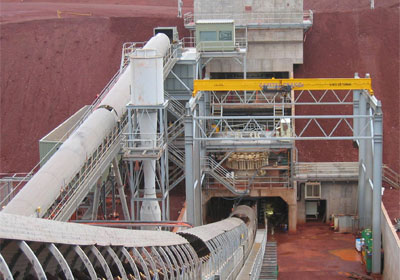Machining: Tantalum has mechanical properties comparable to steel and machining properties comparable to copper. Although there is greater tendency to gall with carbide tools than with high speed tools, both types of tooling are used successfully without galling. Generous use of lubricant (coolant) is essential. Water soluble cutting fluids and vegetable oil work well.
Unannealed tantalum machines better than annealed material because of greater surface hardness. If galling occurs, tears in the surface will be visible. Careful attention to feeds and speeds will prevent galling. Drilling: Drilling can be done with standard high speed drills. Adequate fluid is a necessary and drill speeds should range from 30 to 40 feet per minute.
Threading: Threading, as on studs by tool point, is usually unsatisfactory. Threads can be easily rolled with standard thread rolling tools.
Grinding: Grinding tantalum is difficult. Most grinding wheels have a tendency to “load,” and silicon carbide wheels such as Carborundum 120-T (for rough grinding) and 120-R or 150-R (for finishing) should be used. An adequate supply of cooling water is desirable.
Pickling: Immediately following degreasing, but just prior to a finishing, parts should be pickled in 9% HF + 32% HNO3 with the balance distilled or deionized water at room temperature. After pickling, parts should be rinsed in distilled or deionized water and dried. The resultant clean surface will yield better welds with reduced tendency toward porosity and will prevent carbon or oxygen dissolution in the molten pool.
Riveting: Tantalum rivets are made by cold upsetting tantalum wire and rod. Riveting is done cold.
Brazing: For low temperature brazes, the surface of the metal (after proper cleaning) can be wet with tin-lead solders, then brazed. An alternate method is to plate the tantalum with a flash of copper, then braze with the desired brazing material. Brazing of Ag-Mn, Au-Ni, Ta-Ti-V and other compositions may be used.
Resistance Welding: Tantalum sheets are routinely joined to each other by resistance welding, especially thin-gauge sheets, 0.030 in. and thinner. While spot welding in air with a timing of one cycle is usually satisfactory, it is advisable to do resistance welding under water. The water prevents contamination of the weld by oxidation and acts as a very efficient cooling mechanism.
Continuous spot welding for seams is frequently used to weld tubes formed from sheet. While the strength off such a weld is less than that of a fusion weld, the method is satisfactory for applications where internal or external pressures are low. RMWA Class 2 electrodes are satisfactory for resistance welding.
Fusion Welding: Gas tungsten-arc (GTA) and electron beam (EB) welding are standard methods for joining tantalum. In both methods, the workpiece must be clean.
In GTA welding, it is essential to protect the weld as well as the heat affected zone above 260°C (500—F) from air to prevent oxidation and subsequent embrittlement of the weld. This is normally done by providing a supply of inert gas (argon or helium; argon preferred) to the tool area by adding the gas in a fabricated jig or cover box. Copper chill bars are often used to increase the cooling rate and to reduce the size of the heat-affected zone.
Electron Beam welding is commonly used to join thick sections, but can also be advantageous for very thin sections. EB welds in thick sections up to 0.75 in. (19 mm) are narrower and deeper than those produced by other methods. When joining thin sections, the narrow weld zone helps reduce distortion.
Other than ensuring that welding is done with only clean parts, normal electron beam welding procedures are adequate.
Stamping and Drawing: Blanking or punching tantalum parts is routinely accomplished. Normally, steel dies and punches are used, allowing a clearing of 6% of metal thickness between the punch and the die. Aluminum bronze or beryllium copper alloys can be used for the tooling. These materials greatly reduce galling.
Normally, annealed sheet is used for deep drawing operations. Tantalum does not work harden at a fast rate. However, when it does, it is most apparent at the top of the drawn part.
With single draw parts, the depth of draw can equal the diameter of the starting blank. With multiple draws, the first draw should have a depth of not more than 40 to 50% of the diameter of the starting blank. Intermediate anneals are determined by the number of draws involved, the severity of the draw and the desired properties of the finished part. These anneals are usually determined experimentally.
Tantalum can be formed by all the normal sheet-metal forming techniques. The metal, in thicknesses of less than 0.060 in., usually can be bent to 180 degrees on a 1T radius without evidence of failure.
Spinning: Beryllium copper, aluminum bronze and, in may cases, steel tools are satisfactory for spinning tantalum. Yellow soap or Johnson’s Wax are suitable lubricants.
Peripheral speeds of approximately 300 feet per minute, with the spinning tool being worked in long sweeping strokes and light pressure are recommended. Using this technique will avoid undue thinning of the metal during forming.
The edges of the part being spun should be trimmed, not only to balance the work, but to remove that part of the metal that is the most highly stressed. While wood forms are adequate, steel is better since tantalum is relatively soft and ductile and will pick up minor surface imperfections from the wood form.
Mechanical Cladding: Tubes and pipes of other metals can be produced where the inside or outside surface of the metal is clad with tantalum sheet to protect against corrosive attack. The application of tantalum sheet is normally done mechanically. While there is not a metallurgical bond, the protective covering of tantalum is adequate for most applications.


